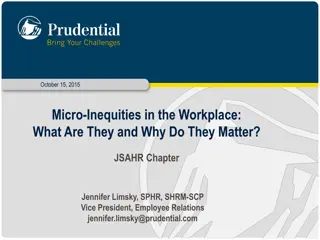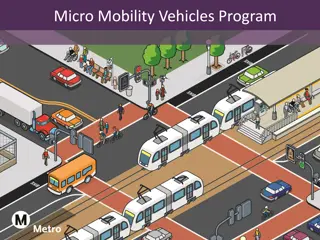
Understanding Labor Market Discrimination
"Explore the concept of employment discrimination in labor markets based on race and gender disparities. Learn about the earnings gap, factors affecting women's wages, and the investigation of female/male earning gaps over the years."
Download Presentation

Please find below an Image/Link to download the presentation.
The content on the website is provided AS IS for your information and personal use only. It may not be sold, licensed, or shared on other websites without obtaining consent from the author. If you encounter any issues during the download, it is possible that the publisher has removed the file from their server.
You are allowed to download the files provided on this website for personal or commercial use, subject to the condition that they are used lawfully. All files are the property of their respective owners.
The content on the website is provided AS IS for your information and personal use only. It may not be sold, licensed, or shared on other websites without obtaining consent from the author.
E N D
Presentation Transcript
HAWKES LEARNING Employment Discrimination Principles of Microeconomics
Employment Discrimination Discrimination involves acting on the belief that members of a certain group are inferior solely because of a factor such as race, gender, or religion. There are many types of discrimination, but the focus here will be on discrimination in labor markets. This arises if workers with the same skill levels receive different pay or have different job opportunities because of their race or gender.
Earnings Gap by Race and Gender A possible signal of labor market discrimination is when an employer pays one group less than another. A gap remains between the average wages of black and white workers and between the average wages of female and male workers.
Earnings Gap by Race and Gender The ratio of wages for black workers to white workers rose substantially in the late 1960s and through the 1970s but has not changed much since then. The ratio of wages for female to male workers changed little through the 1970s but has risen substantially since the 1980s.
Earnings Gap by Race and Gender An earnings gap between average wages, in and of itself, does not prove that discrimination is occurring in the labor market. We need to apply the same productivity characteristics to all parties (employees) involved. Gender discrimination occurs when employers pay women less than men despite having comparable education, experience, and expertise. Racial discrimination exists when employers pay employees less than their coworkers of another race who hold similar jobs with similar educational attainment and expertise.
Investigating the Female/Male Earnings Gap In 2014, 72% of men held jobs vs. 58.1% of women. 1971: 44% of bachelor degrees went to women. 2014: 56% of bachelor degrees went to women. 1970: 5.4% of law degrees and 8.4% of medical degrees went to women. 2014: 47% of law degrees and 48% of medical degrees went to women.
Factors That Can Lower Womens Average Wages Women are likely to bear a disproportionately large share of household responsibilities. A mother of young children is more likely to drop out of the labor force for several years or work on a reduced schedule than the father. As a result, women in their thirties and forties are likely, on average, to have less job experience than men. In the United States, childless women with the same education and experience levels as men are typically paid comparably. However, women with families and children are typically paid about 7% to 14% less than other women of similar education and work experience.
Investigating the Black/White Earnings Gap Blacks experienced blatant labor market discrimination during much of the twentieth century. Until the passage of the Civil Rights Act of 1964, it was legal in many states to refuse to hire a black worker, regardless of the credentials or experience of that worker. Moreover, blacks were often denied access to educational opportunities, which in turn meant that they had lower levels of qualifications for many jobs.
Investigating the Black/White Earnings Gap The earnings gap between black and white workers has not changed as much as the gap between men and women in the last half century. The remaining racial gap seems related both to continuing differences in education levels and to the presence of discrimination. Educational Attainment by Race and Ethnicity in 2015 (U.S. Census Bureau) White Hispanic Black Asian Completed four years of high school or more 93.0% 66.7% 87.0% 89.1% Completed four years of college or more 36.2% 15.5% 22.5% 53.9%
Competitive Markets and Discrimination Gary Becker, who won the Nobel Prize in economics in 1992, was one of the first to analyze discrimination in economic terms. While competitive markets can allow some employers to practice discrimination, it can also provide profit-seeking firms with incentives not to discriminate. Given these incentives, Becker explored the question of why discrimination persists. If a business is located in an area with a large minority population and refuses to sell to minorities, it will cut into its own profits. If some businesses refuse to pay women/minorities a wage based on their productivity, other profit-seeking employers can hire them.
Public Policies to Reduce Discrimination A first public policy step against discrimination in the labor market is to make it illegal. The Equal Pay Act of 1963 said that employers must pay men and women who do equal work the same. The Civil Rights Act of 1964 prohibits employment discrimination based on race, color, religion, sex, or national origin. The Age Discrimination in Employment Act of 1967 prohibited discrimination on the basis of age against individuals who are forty years of age or older. The Pregnancy Discrimination Act of 1978 was aimed at prohibiting discrimination against women in the workplace who are planning to get pregnant, are pregnant, or are returning after pregnancy.
Affirmative Action Affirmative action is the name given to active efforts by government or businesses that give special rights to minorities in hiring and promotion to make up for past discrimination. In its limited and not especially controversial form, it means making an effort to reach out to a broader range of minority candidates for jobs. In its more aggressive and controversial form, it means requiring government and companies to hire a specific number or percentage of minority employees.
An Increasingly Diverse Workforce Racial and ethnic diversity is on the rise in the U.S. population and work force. This graph shows projected changes in the ethnic makeup of the U.S. population by 2060.
Societys Outlook Optimist View: Pessimist View: The growing proportions of minority workers will break down remaining discriminatory barriers and the economy will benefit. The social tensions will rise and workers will be less productive as a result. Anti-discrimination policy, at its best, seeks to help society move toward the more optimistic outcome.
Summary Discrimination occurs in a labor market when workers with the same economic characteristics such as education, experience, and skill are paid different amounts because of race, gender, religion, age, or disability status. In the United States, female workers on average earn less than male workers, and black workers on average earn less than white workers. Free markets can allow discrimination to occur, but the threat of a loss of sales or a loss of productive workers can also create incentives for a firm not to discriminate. A range of public policies can be used to reduce earnings gaps between men and women or between white and other racial/ethnic groups: requiring equal pay for equal work and attaining more equal educational outcomes. HAWKES LEARNING





















